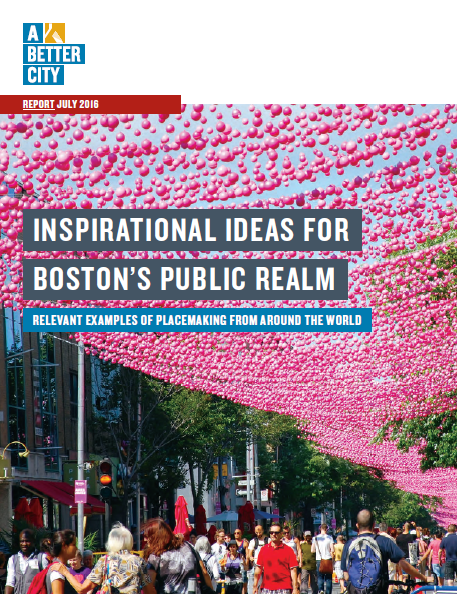Inspirational Ideas for Boston’s Public Realm
July 18, 2016
 The latest generation of urban dwellers wants to live and work in urban places that provide opportunities to play, exercise, eat, and shop. This urban trend puts what is known as the “public realm” in the center of urban design and planning. Public realm refers to all open and enclosed spaces that can be accessed and used by the public. We are currently witnessing a growing interest in reclaiming the public realm for social, cultural and economic activities and American cities are no stranger to this trend. Until the mid-20th century, the public realm was the center of urban life. However, with the rise of the automobile industry and suburban development that privileged private homes and spaces, Americans started to slowly abandon the public sphere. Shopping malls grew faster than commercial Main Streets. Enclosed arcades replaced outdoor carnivals. Gym memberships substituted daily strolls in the park. By the end of the 20thcentury, the public realm of American cities became a leftover space between buildings, a space of transition rather than connection.
The latest generation of urban dwellers wants to live and work in urban places that provide opportunities to play, exercise, eat, and shop. This urban trend puts what is known as the “public realm” in the center of urban design and planning. Public realm refers to all open and enclosed spaces that can be accessed and used by the public. We are currently witnessing a growing interest in reclaiming the public realm for social, cultural and economic activities and American cities are no stranger to this trend. Until the mid-20th century, the public realm was the center of urban life. However, with the rise of the automobile industry and suburban development that privileged private homes and spaces, Americans started to slowly abandon the public sphere. Shopping malls grew faster than commercial Main Streets. Enclosed arcades replaced outdoor carnivals. Gym memberships substituted daily strolls in the park. By the end of the 20thcentury, the public realm of American cities became a leftover space between buildings, a space of transition rather than connection.
As land development patterns continue to shift towards higher density and mixed-use development, the public realm is regaining the attention it deserves as a vital part of urban life. This new generation of urban dwellers is not only reclaiming the public realm but also redefining it dramatically. Years ago, urban dwellers were happy with more straightforward public spaces for relaxing. Today, city residents expect spaces to perform. People want more than a beautiful urban space; they want places that allow them to interact with other people and their surroundings. A vibrant, inclusive, and adaptable public realm is key for any city to stay attractive and competitive while also asserting its place as a global city. At the same time, resources for public spaces and infrastructure are often scarce in both the public and private sector. Boston is no exception to this rule. If the city’s economic future depends on the quality of its public realm but faces limited resources for public space projects, how can the city accomplish these goals?
With this question in mind, A Better City partnered with the Boston Transportation Department to find solutions to Boston’s public realm challenges through the Go Boston 2030 Public Realm Planning Study. The study is part of the Go Boston 2030 initiative, partially funded by the Barr Foundation. During the past year our consultant team, Stantec’s Urban Places Group, researched national and international strategies to address public realm challenges and took away some key lessons. What have we learned? When it comes to public realm improvements, go “light, cheap, (and) quick.” This is the mantra of a people-centered national and international planning movement, known in the United States as “placemaking.” And what have we done with this research? As part of the research process, Stantec’s Urban Places Group assembled Inspirational Ideas for Boston’s Public Realm, a document that summarizes and categorizes key placemaking strategies to transform the quality and user experience of urban spaces. While strategies vary, they all reclaim underutilized urban spaces for people and empower communities to take action through a bottom-up approach to planning. We hope it helps you identify missed opportunities and inspires you to focus on the importance of the public realm in your own work, a critical way to transform forgotten urban spaces and build important places for connection and community across the city. We encourage you to share with us the great ideas this report has inspired or guided.




